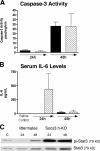Regulation of liver regeneration and hepatocarcinogenesis by suppressor of cytokine signaling 3
- PMID: 18158318
- PMCID: PMC2234364
- DOI: 10.1084/jem.20070820
Regulation of liver regeneration and hepatocarcinogenesis by suppressor of cytokine signaling 3
Abstract
Suppressor of cytokine signaling 3 (SOCS3) down-regulates several signaling pathways in multiple cell types, and previous data suggest that SOCS3 may shut off cytokine activation at the early stages of liver regeneration (Campbell, J.S., L. Prichard, F. Schaper, J. Schmitz, A. Stephenson-Famy, M.E. Rosenfeld, G.M. Argast, P.C. Heinrich, and N. Fausto. 2001.J. Clin. Invest. 107:1285-1292). We developed Socs3 hepatocyte-specific knockout (Socs3 h-KO) mice to directly study the role of SOCS3 during liver regeneration after a two-thirds partial hepatectomy (PH). Socs3 h-KO mice demonstrate marked enhancement of DNA replication and liver weight restoration after PH in comparison with littermate controls. Without SOCS3, signal transducer and activator of transcription 3 (STAT3) phosphorylation is prolonged, and activation of the mitogenic extracellular signal-regulated kinase 1/2 (ERK1/2) is enhanced after PH. In vitro, we show that SOCS3 deficiency enhances hepatocyte proliferation in association with enhanced STAT3 and ERK activation after epidermal growth factor or interleukin 6 stimulation. Microarray analyses show that SOCS3 modulates a distinct set of genes, which fall into diverse physiological categories, after PH. Using a model of chemical-induced carcinogenesis, we found that Socs3 h-KO mice develop hepatocellular carcinoma at an accelerated rate. By acting on cytokines and multiple proliferative pathways, SOCS3 modulates both physiological and neoplastic proliferative processes in the liver and may act as a tumor suppressor.
Figures







References
-
- Alexander, W.S., and D.J. Hilton. 2004. The role of suppressors of cytokine signaling (SOCS) proteins in regulation of the immune response. Annu. Rev. Immunol. 22:503–529. - PubMed
-
- Croker, B.A., D.L. Krebs, J.G. Zhang, S. Wormald, T.A. Willson, E.G. Stanley, L. Robb, C.J. Greenhalgh, I. Forster, B.E. Clausen, et al. 2003. SOCS3 negatively regulates IL-6 signaling in vivo. Nat. Immunol. 4:540–545. - PubMed
-
- Streetz, K.L., T. Wustefeld, C. Klein, K.J. Kallen, F. Tronche, U.A. Betz, G. Schutz, M.P. Manns, W. Muller, and C. Trautwein. 2003. Lack of gp130 expression in hepatocytes promotes liver injury. Gastroenterology. 125:532–543. - PubMed
-
- Yang, X.P., F. Schaper, A. Teubner, F. Lammert, P.C. Heinrich, S. Matern, and E. Siewert. 2005. Interleukin-6 plays a crucial role in the hepatic expression of SOCS3 during acute inflammatory processes in vivo. J. Hepatol. 43:704–710. - PubMed
-
- Schaper, F., C. Gendo, M. Eck, J. Schmitz, C. Grimm, D. Anhuf, I.M. Kerr, and P.C. Heinrich. 1998. Activation of the protein tyrosine phosphatase SHP2 via the interleukin-6 signal transducing receptor protein gp130 requires tyrosine kinase Jak1 and limits acute-phase protein expression. Biochem. J. 335:557–565. - PMC - PubMed
Publication types
MeSH terms
Substances
Associated data
- Actions
Grants and funding
LinkOut - more resources
Full Text Sources
Other Literature Sources
Medical
Molecular Biology Databases
Research Materials
Miscellaneous

